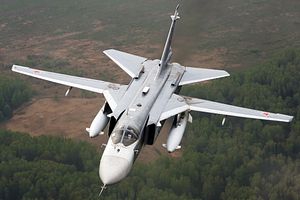The Japan Air Self-Defense Force (JASDF) scrambled fighter jets to intercept one Su-27 Sukhoi Su-27 air superiority fighter, one Sukhoi Su-24 nuclear-capable strike attack aircraft, and one unidentified plane of the Russian Air Force in the Sea of Japan on September 19, the Japanese Ministry of Defense (MoD) said in a statement. The three Russian military aircraft conducted their aerial patrol over international waters. Japanese airspace was not violated, according to the MoD.
The Russian Air Force has recently been stepping up its presence in the Sea of Japan and the Japanese archipelago. Earlier this month on September 4, the JASDF scrambled its aircraft in response to two long-range Tupolev Tu-142MZ maritime reconnaissance and anti-submarine warfare aircraft circumnavigating the major Japanese islands. On that same day, a Russian Air Force Su-24, a variable-sweep wing, twin-engine nuclear-capable attack bomber, also conducted an aerial patrol over the Sea of Japan.
The JASDF also scrambled fighter jets to intercept two nuclear-capable Tupolev Tu-95MS strategic bombers and Sukhoi Su-35S (Flanker-E+) fighter jets in July. Additionally, Japanese fighter jets took to the sky to intercept two Russian Air Force Tu-95MS strategic bombers, escorted by Su-35S fighter jets, back in February. The Russian Air Force only resumed regular aerial patrols in 2014 following the deterioration of Western and Japanese relations with Moscow as a result of the war in Eastern Ukraine in 2014.
As I reported previously, the JASDF’s aircraft of choice for interception missions are license-built variants of the F-15s and F-16:
The JASDF usually dispatches Mitsubishi F-15J all-weather air superiority fighters, 215 of which — including the upgraded F-15DJ/F-15J Kai variants — are currently operationally deployed with the service.
The JASDF’s other workhorse for interceptor missions is the F-2 multirole fighter jet, a Mitsubishi license-produced variant of Lockheed Martin’s F-16, of which there are currently around 90 officially in service.
In 2016, the JASDF has doubled the number of fighter jets dispatched for each intercept of foreign military aircraft approaching Japanese airspace from two to four.
The doubling of aircraft dispatched for each mission is a result of increasingly larger Chinese and Russian formations conducting exercise and patrols near Japanese airspace. As I noted in September:
According to the Japanese MoD, the JASDF dispatched interceptor aircraft 904 times in response to unidentified aircraft approaching Japanese airspace during the last fiscal year that ended in March. Out of the total of 904, 500 scrambles occurred in response to Chinese military aircraft and 390 were prompted by Russian military planes. This marks a decline of 41 percent for Chinese military aircraft, but a 29 percent increase of intercepts of Russian planes.
Last week, Russia concluded its largest military exercise since the early 1980s, dubbed Vostok (Eastern) 2018, in Siberia and Russia’s Far East, where it simulated a large-scale conventional war against the United States and its allies including Japan.

































